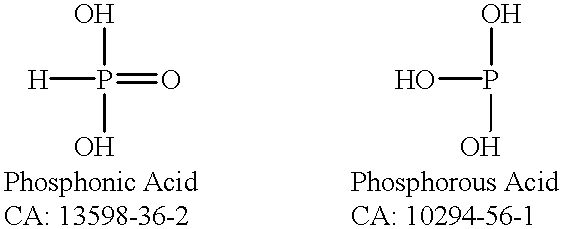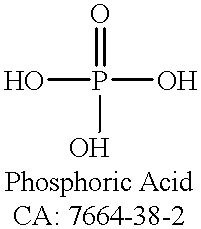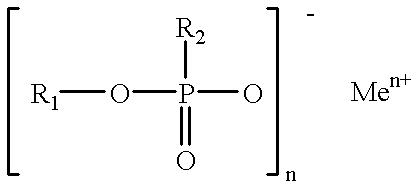Compositions for plants containing phosphonate and phosphate salts, and derivatives thereof
a technology of phosphonate and phosphate salt, which is applied in the directions of phosphorous compound active ingredients, biocide, application, etc., can solve the problems of infected plants defoliation, unsuitable consumption, and rapid decay of potatoes, and achieve the effect of preventing the infection of phytophthora infestans
- Summary
- Abstract
- Description
- Claims
- Application Information
AI Technical Summary
Benefits of technology
Problems solved by technology
Method used
Image
Examples
example 1
Potatoes (Solanum tuberosum, variation Atlantic) were infected with a pathogen, Phytophthora infestans, to determine whether suitable treatments could be developed to eliminate the pathogen from the infected plants and, more importantly, prevent infection of the plants by the pathogen. The Phytophthora pathogen causes late blight in infected plants. The plants were treated with the below listed compositions, twice, with the applications being seven (7) days apart. The composition of the inoculant added to the plants is listed below in the table. One week (7 days) after the last inoculation was made to the plants, the potato plants were then infected with the pathogen, Phytophthora infestans. The infectious inoculum was equal to 12,000 sporangia per millimeter (ml), with 20 ml administered per plant. The Genotype of the pathogen was US-8 and the Matingtype was A2. Seven days after inoculation with the pathogen, the results were tabulated to determine the percentage of blight in the p...
example 2
Tomatoes (Lycopersicon esculentum, FL 40) were infected with a pathogen, Phytophthora infestans, to determine whether suitable treatments could be developed to prevent infection of the plants by the pathogen. The Phytophthora pathogen causes late blight in infected plants. The plants were treated with the below listed compositions, twice, with the application dates being seven (7) days apart. The composition of the inoculant added to the plants is listed below in the table. One week (7 days) after last inoculation was made to the plants, the tomato plants were then infected with the pathogen, Phytophthora infestans. The infectious inoculum was equal to 12,000 sporangia per millimeter (ml), with 20 ml administered per plant. The Genotype of the pathogen was US-17 and the Matingtype was Al. Seven days after inoculation with the pathogen, the results were tabulated to determine the percentage of blight in the plants and the number of lesions per plant. Additionally, the number of infec...
PUM
| Property | Measurement | Unit |
|---|---|---|
| pH | aaaaa | aaaaa |
| pH | aaaaa | aaaaa |
| valence | aaaaa | aaaaa |
Abstract
Description
Claims
Application Information
 Login to View More
Login to View More - R&D
- Intellectual Property
- Life Sciences
- Materials
- Tech Scout
- Unparalleled Data Quality
- Higher Quality Content
- 60% Fewer Hallucinations
Browse by: Latest US Patents, China's latest patents, Technical Efficacy Thesaurus, Application Domain, Technology Topic, Popular Technical Reports.
© 2025 PatSnap. All rights reserved.Legal|Privacy policy|Modern Slavery Act Transparency Statement|Sitemap|About US| Contact US: help@patsnap.com



